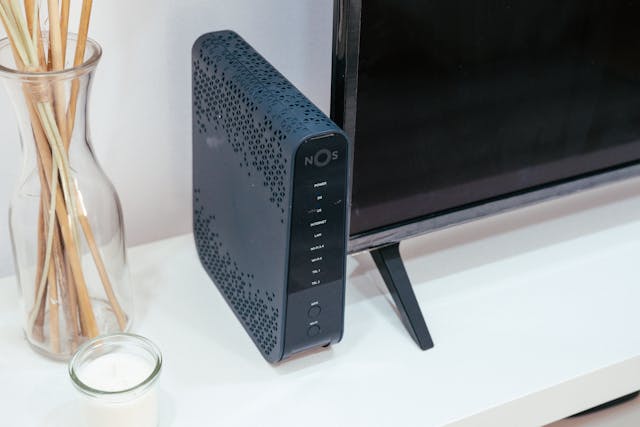
How does Wi-Fi work? Wi-Fi transmits information from a router to your device and vice versa using radio waves, which is why you can use it without a cable. I always thought Wi-Fi stood for “wireless fiber”, but apparently, it doesn’t actually stand for anything, and is just a brand name.
The technology behind Wi-Fi has been around for a while, but it wasn’t used properly until 1997 when the technology was standardized by the Institute of Electrical and Electronics Engineers (IEEE). When it was first used, the standard was 1 Mbps. These days, commercial Wi-Fi can reach 5.6 gigabits per second and the fastest ever recorded Wi-Fi speed is 402 Terabits per second. The name Wi-Fi was chosen by the IEEE from a list of ten possible names thought up by a marketing agency called Interbrand. Many people (me included) think that it stands for Wireless Fiber, but it doesn’t. It also doesn’t stand for wireless fidelity. The name was possibly chosen because it is similar to Hi-Fi (High Fidelity), which was big in the late 1990s, but it doesn’t. Wi-Fi is purely a name that doesn’t stand for anything.
The technology that Wi-Fi uses wasn’t invented by one person and came from a whole range of different countries. That made it somewhat tricky to use in the beginning because all those countries owned some of the necessary patents. The first use of Wi-Fi was to connect some of the Hawaiian Islands. It was then used to connect a series of cash registers in the US. It didn’t really become mainstream until Apple started to use it with their iBooks in 1999. Now, none of us could live without some form of Wi-Fi.
So, how does it work? The way it works is technically simple. Our computers process everything we do and see on our computers as binary. Binary just means that the computer only uses 1s and 0s. We say 1 and 0, but it is not actually a number. The 1 and 0 mean that an electrical current is flowing or not flowing. Our computers process information in bits, which is the smallest possible unit. The computer has capacitors that have spaces for electrons to fit in. If an electron is in the capacitor, it is on, which is a 1, and if the capacitator is empty, it is off, which is a 0. The computer strings these bits together to make information. Everything is made of these on / of states.
To get information from the internet, the computer needs to transmit and receive these 1s and 0s. the series of 1s and 0s it receives will tell the computer where to put the electrons and that will tell the computer what information to display that we can actually understand. If your computer is connected to the internet via a fiber optic cable, then the 1s and 0s are translated into light that is sent along the table. If you are connected to Wi-fi, then the 1s and 0s have to be translated into radio waves. The computer and the router do this by modulating the radio wave. All waves have frequency and amplitude. The frequency is how often waves come in a give time. The amplitude is how high each wave is. The modulator in the computer will change either the frequency or the amplitude of the radio wave for a 1 and leave it unchanged for a 0. For example, it might do two waves in the time of one wave for a 1 and one wave for a 0. Or it might do a high wave for a 1 and a low wave for a 0. This depends on the system being used. Each 1 and 0 will be translated into a radio wave and sent to the router, or from the router to your computer, but the computer and router will send billions of these bits of information a second.
Just like the radio that we listen to, radio waves can be transmitted on many different frequencies to avoid interference. Your Wi-fi speed will depend on what kind of Wi-fi you are using. Modern Wi-fi can transmit 450 megabits per second, but they can transmit on more than one stream at the same time. That means, it can send information on multiple frequencies at the same time, vastly increasing the amount of data it can transfer.
The radio waves that Wi-fi uses are wonderful because they can pass through most substances that are used to build houses. The wave frequency of radio waves are much larger than the gaps between the atoms in a wall and they pass through without hitting the atoms. That means, if your router is in another room, it will still be able to communicate with your computer. However, if the walls are thicker, or if there are a lot of walls, it could block the signal. Also, the signal will increase with distance because it will be harder for the router to accurately hit your computer with the radio waves, and vice versa. And this is what I learned today.
Try these:
Sources
https://www.wifirst.com/en/blog/thehistoryofwifitechnology
https://en.wikipedia.org/wiki/Wi-Fi
https://www.britannica.com/story/how-does-wi-fi-work
https://computer.howstuffworks.com/wireless-network.htm
https://www.newscientist.com/question/what-does-wi-fi-stand-for
https://www.techtarget.com/whatis/definition/bit-binary-digit
https://electronics.stackexchange.com/questions/98118/capacitor-that-stores-one-bit-of-information
Photo by Jaycee300s : https://www.pexels.com/photo/a-router-a-monitor-and-incense-sticks-18071864/
